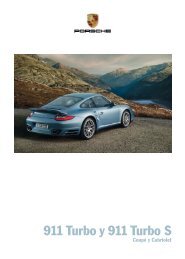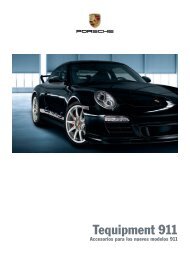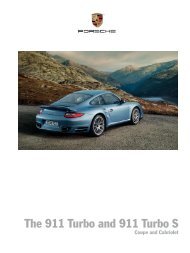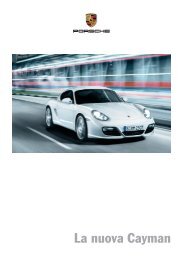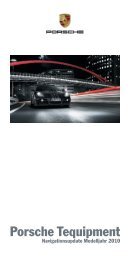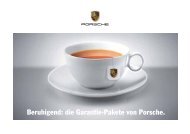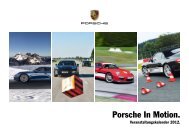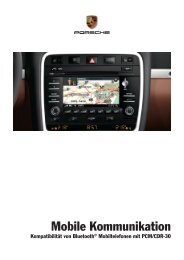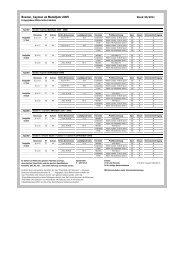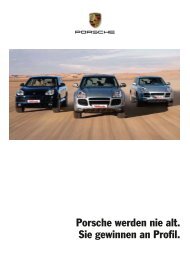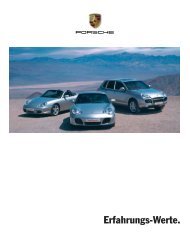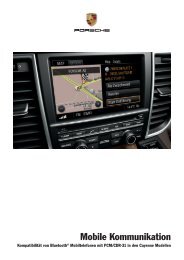You also want an ePaper? Increase the reach of your titles
YUMPU automatically turns print PDFs into web optimized ePapers that Google loves.
<strong>The</strong> <strong>new</strong> <strong>911</strong> <strong>GT2</strong> <strong>RS</strong><br />
Awe
<strong>The</strong> <strong>new</strong> <strong>911</strong> <strong>GT2</strong> <strong>RS</strong> 6<br />
Engine 12<br />
G-force 16<br />
Ground control 20<br />
Atmosphere 24<br />
Checklist 30<br />
Technical data 34
<strong>The</strong> <strong>new</strong> <strong>911</strong> <strong>GT2</strong> <strong>RS</strong><br />
| 6
Always there if you go to the extreme:<br />
Awe.<br />
<strong>The</strong> standard could hardly<br />
have been set any higher: the<br />
<strong>911</strong> <strong>GT2</strong>. <strong>The</strong> aim: to surpass it.<br />
<strong>The</strong> method: Porsche Intelligent<br />
Performance. <strong>The</strong> result: the<br />
<strong>new</strong> <strong>911</strong> <strong>GT2</strong> <strong>RS</strong>.<br />
Not a muscle too few. Not a gram<br />
too much. No more than 500 cars<br />
available. Never was there a more<br />
powerful road car produced by<br />
Porsche.<br />
Were there any reservations?<br />
Negative thoughts? Doubts? Not in<br />
the slightest. Fear? No chance.<br />
Our engineers experienced just<br />
one feeling: awe. Before they<br />
started. And definitely after they<br />
had finished.<br />
A feeling that goes with you.<br />
Every foot, every second.<br />
Technology.<br />
Some figures cause astonishment,<br />
others create awe. <strong>The</strong> increased<br />
power of the 3.6 Liter Boxer<br />
engine means that it now delivers<br />
620 hp and maximum torque is<br />
516 lb.-ft., which is 90 hp and<br />
11 lb.-ft. more than the <strong>911</strong> <strong>GT2</strong>.<br />
<strong>The</strong> <strong>911</strong> <strong>GT2</strong> <strong>RS</strong> sprints from<br />
0–60 mph in 3.4 seconds. Track<br />
Speeds from 0 to 124 mph in<br />
9.8 seconds. And from 0–186 mph<br />
in 28.9 seconds. Right up to<br />
205 mph.<br />
<strong>The</strong> main factor responsible for<br />
this extra power is Porsche Intelligent<br />
Performance. An efficiencybased<br />
concept incorporated inside<br />
every Porsche, resulting in the<br />
effective lightweight design for<br />
example. And the reason why<br />
the <strong>911</strong> <strong>GT2</strong> <strong>RS</strong> is 100 lbs. lighter<br />
than the <strong>911</strong> <strong>GT2</strong>.<br />
<strong>The</strong> body is .5" wider at the front,<br />
allowing a .5" wider track and<br />
wider tires. <strong>The</strong> 19" <strong>GT2</strong> <strong>RS</strong> wheels<br />
with central locking device also<br />
provide exceptional driving<br />
dynamics.<br />
<strong>The</strong> ride height, camber, toe angle,<br />
and the stabilizers on the front and<br />
rear axles can be adjusted individually<br />
for the racetrack. <strong>The</strong> fact that<br />
the chassis is connected more<br />
rigidly to the body allows for even<br />
more precise steering. For exact<br />
driving and control.<br />
High performance demands a<br />
high level of safety. So the <strong>new</strong><br />
<strong>911</strong> <strong>GT2</strong> <strong>RS</strong> has Porsche Active<br />
Suspension Management (PASM),<br />
Porsche Stability Management<br />
(PSM) and Porsche Ceramic<br />
Composite Brakes (PCCB) fitted as<br />
standard. Additional brake ducts<br />
on the rear axle ensure that the<br />
brakes are effectively ventilated.<br />
<strong>The</strong> end result: no series-produced<br />
Porsche has ever reached this<br />
level of performance. None has<br />
achieved faster track times.<br />
None has deserved more awe.<br />
7 |
Lightweight construction.<br />
Anyone who wants to go beyond<br />
the horizon has to work on their<br />
performance – and concentrate<br />
on strength. <strong>The</strong> way to achieve<br />
this is to make sacrifices. But only<br />
with regard to weight. <strong>The</strong> <strong>new</strong><br />
<strong>911</strong> <strong>GT2</strong> <strong>RS</strong> is 154 lbs. lighter<br />
than the <strong>911</strong> <strong>GT2</strong>. Its weight-topower<br />
ratio: just 4.95 lb./hp. For<br />
excellent performance. And with<br />
relatively moderate fuel consumption.<br />
This is achieved thanks to a whole<br />
series of modifications. In parti cular,<br />
the use of materials that are more<br />
typically found in motorsports. <strong>The</strong><br />
front lid, the side air intakes on the<br />
charge air cooler, the slats in front<br />
of the front lid, the rear middle<br />
section, the rear spoiler lip and the<br />
rear wing are all constructed from<br />
carbon fiber. As are the lightweight<br />
sport bucket seats and door sills<br />
with the <strong>RS</strong> logo. <strong>The</strong> front mud<br />
flaps are also available in carbon<br />
fiber as an option.<br />
| 8<br />
Instead of the usual steel, the<br />
diagonal struts on the rear axle<br />
are made from aluminum. As are<br />
the fixed calipers of the PCCB on<br />
the front and rear axle. <strong>The</strong> engine<br />
cover is made from a synthetic<br />
material. In addition to this, the<br />
<strong>new</strong> <strong>911</strong> <strong>GT2</strong> <strong>RS</strong> has lightweight<br />
door panels with side pads and<br />
door pulls. Throughout the body,<br />
much of the soundproofing has<br />
been removed and the interior<br />
soundproofing has also been<br />
reduced.<br />
<strong>The</strong> lightweight single mass<br />
flywheel makes the engine even<br />
more responsive. Weight has<br />
even been reduced in the body<br />
structure: there are no fittings for<br />
a roof transport system and there<br />
are no reinforcements for fastening<br />
the seat belts in the floor.<br />
<strong>The</strong> battery in the <strong>new</strong> <strong>911</strong> <strong>GT2</strong> <strong>RS</strong><br />
is also lighter. A lithium ion battery,<br />
which provides an additional weight<br />
saving of over 22 lbs. compared to<br />
the conventional standard battery,<br />
is available as an option. <strong>The</strong><br />
lithium ion battery is inserted in<br />
the vehicle and can easily replace<br />
the standard battery for use on<br />
the racetrack.<br />
In addition, you can opt to do<br />
without the CDR-30 audio system<br />
and air conditioning. To achieve<br />
an even higher power-to-weight<br />
ratio.<br />
Design.<br />
Even the appearance of the <strong>new</strong><br />
<strong>911</strong> <strong>GT2</strong> <strong>RS</strong> leaves no room for<br />
doubt: it is more powerful than<br />
before.<br />
Power is demanding. So, with<br />
regard to aerodynamics, the design<br />
has been aimed at achieving the<br />
best possible cooling and the<br />
greatest possible downforce. <strong>The</strong><br />
large air inlets ensure that the air<br />
is directed straight to the central<br />
radiator and the front brakes. <strong>The</strong><br />
carbon fiber air outlet in front of<br />
the front lid guides the air flowing<br />
through the central radiator up<br />
over the vehicle, thus increasing<br />
the downforce on the front axle.<br />
Immediately noticeable are the<br />
front fenders which are .5" wider,<br />
enabling a wider track and the<br />
use of wider tires. <strong>The</strong> 19" <strong>GT2</strong> <strong>RS</strong><br />
wheels have a white gold metallic<br />
finish.<br />
A further striking feature is the<br />
black <strong>GT2</strong> <strong>RS</strong> logo on the side.<br />
<strong>The</strong> rear with a carbon fiber middle<br />
section makes an impression. And<br />
the carbon fiber lip on the fixed<br />
rear wing sits .39" (10 mm) higher.<br />
For extreme driving stability.<br />
For greater efficiency and more<br />
engine power, as the speed increases,<br />
additional air is pressed<br />
into the intake channel through<br />
the air inlet channels in the wing<br />
supports. This ram air system<br />
builds up the air in front of the<br />
turbochargers. This relieves the<br />
turbochargers, thus lowering<br />
exhaust gas back pressure and<br />
increasing engine power.<br />
To sum up: a drag coefficient<br />
value of only 0.34. Along with<br />
increased downforce on the front<br />
and rear axles. For better road<br />
holding, greater stability and<br />
excellent handling. In short, a<br />
design that fulfils its purpose:<br />
to create awe.
Front lid and side air intakes for the charge air cooler in carbon<br />
Rear middle section and rear wing lip in carbon<br />
Exterior mirrors with carbon casing<br />
9 |
Engine<br />
| 12
3, 2, 1, 0.<br />
Takeoff.<br />
Engine.<br />
<strong>The</strong> engineers k<strong>new</strong> exactly what<br />
their objective was: to make the<br />
<strong>new</strong> <strong>911</strong> <strong>GT2</strong> <strong>RS</strong> the most powerful<br />
Porsche for the road.<br />
Objective achieved. <strong>The</strong> watercooled<br />
six-cylinder bi-turbo Boxer<br />
engine with four-valve technology,<br />
variable turbine geometry (VTG)<br />
and VarioCam Plus delivers its<br />
power through the rear axle. From<br />
a displacement of 3.6 Liters, it<br />
generates an enormous 620 hp<br />
at an engine speed of 6.<br />
500 rpm. <strong>The</strong> maximum torque of<br />
516 lb.-ft.<br />
is available from 2,250 rpm. From<br />
0 to 60 mph takes just 3.4 seconds.<br />
To 124 mph only 9.8 seconds,<br />
and to 186 mph just 28.9 seconds.<br />
<strong>The</strong> weight-to-power ratio that is<br />
essential for this kind of performance<br />
is just 4.95 lb./hp.<br />
A consistent supply of oil to the<br />
engine – even at high cornering<br />
speeds – is achieved using a<br />
dry sump lubrication system with<br />
a separate engine oil reservoir.<br />
<strong>The</strong> oil is cooled by an oil-water<br />
heat exchanger.<br />
Variable turbine geometry (VTG).<br />
Unlike a conventional turbo, the<br />
incoming exhaust gas is directed<br />
onto the turbine by electronically<br />
Power (hp)<br />
707<br />
652<br />
598<br />
544<br />
489<br />
435<br />
381<br />
326<br />
272<br />
218<br />
143<br />
109<br />
54<br />
0<br />
1000<br />
516 lb. ft.<br />
2000 3000 4000 5000 6000 7000<br />
<strong>911</strong> <strong>GT2</strong> <strong>RS</strong>: 516 lb.-ft. at 2,250 – 5,500 rpm, 620 hp at 6,500 rpm<br />
controlled guide vanes. <strong>The</strong> angle<br />
of these vanes can be adjusted so<br />
that the flow speed of the exhaust<br />
gas and, therefore, the momentum<br />
on the turbine can be changed.<br />
This means that a large amount of<br />
power can be generated from the<br />
turbo even at low engine speeds<br />
with small amounts of exhaust gas<br />
– for much higher boost pressure,<br />
excellent cylinder filling and more<br />
torque.<br />
Engine speed (rpm)<br />
620 hp<br />
678<br />
649<br />
619<br />
590<br />
560<br />
531<br />
501<br />
472<br />
442<br />
413<br />
383<br />
354<br />
324<br />
295<br />
Torque (lb. ft.)<br />
<strong>The</strong> torque curve therefore rises<br />
sooner – and then stays uniformly<br />
high for a long time. <strong>The</strong> increase<br />
in power and torque is helped not<br />
only by the fact that the maximum<br />
boost pressure has been increased<br />
to 23 psi, but also by<br />
the <strong>new</strong> charged air cooler in the<br />
<strong>911</strong> <strong>GT2</strong> <strong>RS</strong>. <strong>The</strong> end result is<br />
an extraordinary response and<br />
acceleration that will leave you<br />
speechless.<br />
13 |
VarioCam Plus.<br />
VarioCam Plus is a two-in-one<br />
engine concept which adapts to<br />
the particular demand for power.<br />
<strong>The</strong> system switches seamlessly<br />
thanks to the engine management<br />
system. <strong>The</strong> result is effortless<br />
acceleration and smoother running.<br />
At medium revs and low engine<br />
loads, the system reduces fuel<br />
consumption and emissions by<br />
lowering the valve lift settings<br />
and advancing the timing. Fuel<br />
economy is especially noticeable<br />
at lower revs. High torque values<br />
and maximum power are achieved<br />
with the high valve lift setting,<br />
which results in exceptional engine<br />
power with comparatively low fuel<br />
consumption.<br />
| 14<br />
Expansion intake manifold.<br />
Essentially, in all intake systems,<br />
the air vibrates. <strong>The</strong>se vibrations<br />
consist of both a compression<br />
phase in which the air is compressed<br />
and also an expansion<br />
phase in which the air expands.<br />
Until now, more air has meant<br />
more power. <strong>The</strong> compression<br />
phase of the air vibrations in the<br />
intake system is used to press<br />
more air into the combustion<br />
chamber. <strong>The</strong> disadvantage is<br />
that, when it is compressed,<br />
the air is also heated. It is therefore<br />
impossible to achieve optimum<br />
ignition of the fuel and<br />
air mixture to maximize power.<br />
<strong>The</strong> expansion intake manifold<br />
adjusts the air vibrations in a com-<br />
pletely different way. It uses the<br />
expansion phase because, when<br />
it expands, the air cools. <strong>The</strong> mixture<br />
in the combustion chamber<br />
therefore becomes cooler – and<br />
optimum ignition can be achieved.<br />
In using the expansion phase,<br />
less air gets into the cylinders.<br />
However, a slight increase<br />
in the charge pressure by the<br />
turbocharger compensates for<br />
this effect. <strong>The</strong> heating of the<br />
air caused by the higher charge<br />
pressure is in turn compensated<br />
by the charged air cooler. <strong>The</strong><br />
result is much higher efficiency<br />
for even greater engine power<br />
and improved fuel consumption<br />
at high loads and engine speeds.<br />
In principle it is quite easy to be in<br />
awe: just breathe deeply.<br />
Power transmission.<br />
<strong>The</strong> lightweight six-speed gearbox<br />
in the <strong>911</strong> <strong>GT2</strong> <strong>RS</strong> is designed<br />
specifically for the large amount<br />
of engine power. <strong>The</strong> gear lever<br />
throw is short and precise – for<br />
rapid and accurate gear changes.<br />
Instead of a dual-mass flywheel as<br />
in the <strong>911</strong> <strong>GT2</strong>, the <strong>911</strong> <strong>GT2</strong> <strong>RS</strong><br />
uses a single mass flywheel. This<br />
is lighter and the engine can rev<br />
more freely in the upper speed<br />
ranges. Also, the gear ratios have<br />
been adjusted specifically for use<br />
on the racetrack.
1<br />
2<br />
3<br />
20<br />
1. Bi-Xenon headlights<br />
2. Radiator module (left)<br />
3. Radiator module (center)<br />
4. Radiator module (right)<br />
5. Coolant pipe<br />
6. Coolant expansion tank<br />
4<br />
19<br />
7. Air filter<br />
8. Exhaust-gas turbocharger<br />
with Variable Turbine<br />
Geometry (VTG)<br />
9. Intercoolers<br />
10. Pressure pipe<br />
22<br />
11. Throttle valve<br />
(electronically actuated)<br />
12. Expansion intake manifold<br />
13. Main silencer (titanium)<br />
14. Tailpipe (titanium)<br />
15. Oil filter<br />
21<br />
5<br />
18<br />
16<br />
16. Engine oil reservoir<br />
(dry-sump lubrication)<br />
17. Generator<br />
18. PASM damper<br />
19. PCCB brake<br />
20. Tandem brake booster<br />
6<br />
12<br />
8<br />
9<br />
11<br />
15<br />
17<br />
10<br />
9<br />
7<br />
13<br />
14<br />
21. 6-speed manual gearbox<br />
22. Sport Bucket Seats<br />
15 |
G-force<br />
| 16
You can still take off<br />
without losing contact with the ground.<br />
Chassis.<br />
<strong>The</strong> requirements for the <strong>new</strong><br />
<strong>911</strong> <strong>GT2</strong> <strong>RS</strong> chassis were high:<br />
driving characteristics that are<br />
typical of a race car, on both the<br />
road and the racetrack.<br />
This car is about 1 inch lower<br />
than the <strong>911</strong> Carrera and its systematic<br />
lightweight construction<br />
keeps the total weight and the<br />
weight of unsprung masses low.<br />
For extraordinary agility, excellent<br />
driving safety and stability, especially<br />
when cornering.<br />
Wider fenders on the front axle<br />
enable a .5 inch wider track<br />
compared to the <strong>911</strong> <strong>GT2</strong> and<br />
the use of wider tires. For even<br />
more grip, improved steering and<br />
higher cornering speeds.<br />
<strong>The</strong> front suspension with<br />
enhanced hub carriers combines<br />
McPherson-type struts with longitudinal<br />
and transverse links. Each<br />
front wheel is precisely located,<br />
ensuring excellent directional<br />
stability and superior handling in<br />
every driving situation.<br />
<strong>The</strong> rear axle has multi-link suspension<br />
featuring LSA construction –<br />
light, stable and agile. <strong>The</strong> reduced<br />
weight design of the rear axle’s<br />
aluminum transverse arm and<br />
diagonal struts ensures excellent<br />
driving dynamics.<br />
Ride height, camber, toe angle and<br />
also the stabilizers on the chassis<br />
can be adjusted on the front and<br />
rear axles and therefore adapted<br />
to the required driving behavior.<br />
<strong>The</strong> rigid connection between the<br />
chassis and the body, e.g. metal<br />
support bearings with ball joints<br />
at the front and the rigid crossmembers<br />
at the rear, makes transmission<br />
less elastic and helps to<br />
ensure more precise steering to<br />
enable better handling.<br />
Cooling air is delivered efficiently<br />
to the front brakes thanks to<br />
the brake air spoiler. In the <strong>new</strong><br />
<strong>911</strong> <strong>GT2</strong> <strong>RS</strong> there is additional<br />
brake ventilation on the rear axle.<br />
In short, the chassis exploits the<br />
road to the full. Inspiring awe.<br />
Wheels.<br />
<strong>The</strong> link between the enormous<br />
power of the <strong>new</strong> <strong>911</strong> <strong>GT2</strong> <strong>RS</strong> and<br />
the road: the white gold metallic<br />
painted 19-inch <strong>GT2</strong> <strong>RS</strong> wheels.<br />
<strong>The</strong>ir central locking device is<br />
anodized and bears the <strong>RS</strong> logo –<br />
also in a white gold metallic finish.<br />
<strong>The</strong> central locking device is<br />
derived from motorsports. Its<br />
advantages include better driving<br />
dynamics and performance thanks<br />
to lower rotating masses. And,<br />
of course, faster wheel changes.<br />
An enormous advantage – especially<br />
on the racetrack.<br />
<strong>The</strong> dimensions: on the front<br />
axle 9 J x 19 with sport tires*<br />
245/35 ZR 19 and on the rear<br />
axle 12 J x 19 with sport tires*<br />
325/30 ZR 19. Tire Pressure<br />
Monitoring System (TPMS) comes<br />
standard and provides early<br />
warning of any tire pressure<br />
loss via a display on the on-board<br />
computer.<br />
19-inch <strong>GT2</strong> <strong>RS</strong> wheel<br />
* Owing to the lower tread profile, there is a risk of aquaplaning on wet roads.<br />
17 |
| 18<br />
Porsche Active Suspension<br />
Management (PASM).<br />
<strong>The</strong> electronic adjustment of the<br />
shock absorber systems actively<br />
and continuously controls the<br />
damping force – depending on<br />
the driving style and situation –<br />
for each individual wheel.<br />
By pressing a button, the driver<br />
can choose between two setup<br />
modes, ‘Normal’ and ‘Sport’.<br />
Normal mode is designed for<br />
general road driving and on the<br />
racetrack in the wet. Sport mode<br />
is specially designed for maximum<br />
lateral acceleration and the best<br />
possible traction on the racetrack.<br />
Porsche Stability Management<br />
(PSM).<br />
<strong>The</strong> limits of driving dynamics.<br />
Those who venture here should<br />
have the necessary equipment –<br />
in addition to driving ability. So,<br />
PSM has been adapted to the<br />
power of the <strong>new</strong> <strong>911</strong> <strong>GT2</strong> <strong>RS</strong>.<br />
<strong>The</strong> principle is that in addition<br />
to the ABS there are two automatic<br />
control systems: stability<br />
control (SC) and traction control<br />
(TC). Stability control (SC) controls<br />
lateral dynamics using a range<br />
of sensors to constantly monitor<br />
the direction, speed, yaw velocity<br />
and lateral acceleration of the<br />
car. This information is used to<br />
calculate the actual direction<br />
of travel. If the car starts to go<br />
off course, stability control (SC)<br />
initiates selective braking on<br />
individual wheels help to stabilize<br />
the vehicle in critical driving<br />
scenarios.<br />
Traction control (TC) with its<br />
integrated ABD (automatic brake<br />
differential), ASR (ant-slip regulation)<br />
and EDC (engine drag-torque<br />
control) functions control the<br />
l ongitudinal dynamics of the car.<br />
This s
port-oriented traction<br />
control improves traction on vary-<br />
ing road surfaces. Traction control<br />
(TC) also helps to limit exessive<br />
forces that can cause the rear<br />
to slide out un controllably under<br />
full power.<br />
<strong>The</strong> special feature of PSM in<br />
the <strong>911</strong> <strong>GT2</strong> <strong>RS</strong> is that these<br />
two systems can be switched<br />
off completely, in two stages.<br />
In the first stage, the ‘SC OFF’<br />
button in the center console disables<br />
the stability control (SC). In<br />
‘SC OFF’ mode, the system does<br />
not intervene if the car goes off<br />
course in the lateral direction.<br />
In addition to deliberate steering<br />
actions, the car can now also be<br />
driven very dynamically into bends<br />
by acting on the throttle. Traction<br />
control (TC) is still active in this<br />
mode.<br />
In the second stage, the separate<br />
‘SC + TC OFF’ button also disables<br />
the traction control (TC). In this<br />
mode, both the lateral dynamics<br />
control and traction control are<br />
19 |
Ground control<br />
| 20
Safety means being able to rely on the<br />
systems working in the background.<br />
Porsche Ceramic Composite<br />
Brake (PCCB).<br />
Being in awe also means knowing<br />
when to brake – when necessary.<br />
<strong>The</strong> <strong>new</strong> <strong>911</strong> <strong>GT2</strong> <strong>RS</strong> is equipped<br />
as standard with the Porsche<br />
Ceramic Composite Brake (PCCB).<br />
This braking technology has already<br />
demonstrated its performance<br />
credentials on the racetrack, for<br />
example, in the vehicles of the<br />
Porsche Mobil 1 Supercup. Its<br />
ceramic brake discs have a diameter<br />
of 14.96 inches (380 mm) at the<br />
front and 13.78 inches (350 mm)<br />
at the back – for excellent braking<br />
power.<br />
<strong>The</strong> ceramic discs are made from<br />
a specially treated carbon fiber<br />
compound that is silicated in a<br />
high-vacuum process at approximately<br />
3,092 °F. <strong>The</strong> resulting<br />
brake discs are much harder and<br />
therefore more resistant to excessive<br />
temperatures than cast iron<br />
discs. Typical of PCCB, the low<br />
thermal expansion prevents deformation<br />
under heavy braking. Furthermore,<br />
the ceramic brake discs<br />
are totally resistant to corrosion<br />
and offer better noise-damping<br />
properties.<br />
<strong>The</strong> use of six-piston aluminum<br />
monobloc fixed calipers on the front<br />
axle and four-piston aluminum<br />
monobloc fixed calipers on the<br />
rear axle ensures a very high and,<br />
above all, constant braking pressure.<br />
<strong>The</strong> brake response is much<br />
faster and more precise and<br />
requires only moderate input.<br />
All the necessary ingredients are<br />
there for short braking distances,<br />
especially in tough conditions.<br />
And safety is also increased when<br />
braking from high speeds, thanks<br />
to the excellent fade resistance<br />
of PCCB.<br />
<strong>The</strong> key advantage of the ceramic<br />
brake system is in the extremely<br />
low weight of the brake discs: they<br />
are approximately 50% lighter than<br />
cast iron discs of similar design<br />
and size. In the <strong>new</strong> <strong>911</strong> <strong>GT2</strong> <strong>RS</strong><br />
the calipers on the front and rear<br />
axles are made from lightweight<br />
aluminum giving an additional<br />
weight saving of approx. 10.5 lbs.<br />
compared with stainless steel<br />
calipers. This doesn’t just have<br />
a positive effect on driving performance<br />
and fuel consumption.<br />
Above all, it means that the<br />
unsprung and rotating masses<br />
are reduced.<br />
<strong>The</strong> result is improved roadholding<br />
and comfort, especially on<br />
uneven roads. As well as greater<br />
agility and even better handling.<br />
Please note that circuit racing,<br />
trackday use and other forms<br />
of performance driving can significantly<br />
reduce the service life<br />
of even the most durable pads<br />
and discs. As with conventional<br />
high-performance braking systems,<br />
we recommend that all<br />
brake components be professionally<br />
inspected and replaced where<br />
necessary after every track event.<br />
21 |
| 22<br />
Bodyshell structure.<br />
<strong>The</strong> reinforced bodyshell of the<br />
<strong>new</strong> <strong>911</strong> <strong>GT2</strong> <strong>RS</strong> contains a highly<br />
resilient passenger cell which<br />
offers exceptional crash protection,<br />
while still ensuring the vehicle<br />
remains lightweight. A system of<br />
longitudinal and transverse members,<br />
patented by Porsche, is<br />
used at the front. In the event of a<br />
collision, this distributes the forces<br />
and minimizes deformation of the<br />
passenger cell. An extremely rigid<br />
bulkhead cross-member made from<br />
super high-strength steel absorbs<br />
impact forces from the front<br />
longitudinal members to help<br />
protect both front footwells.<br />
Reinforced doors contribute to<br />
the overall rigidity of the car. In<br />
the event of a front impact, an<br />
additional load path is used to<br />
channel energy through the upper<br />
part of the bodyshell and thus<br />
further protect the passenger<br />
cell. Easily replaceable collision<br />
elements protect the bodyshell<br />
in minor accidents.<br />
<strong>The</strong> high proportion of aluminum<br />
alloys and high-strength steel<br />
used contributes towards the<br />
good power-to-weight ratio of<br />
the <strong>911</strong> <strong>GT2</strong> <strong>RS</strong>.<br />
Driver and passenger airbags.<br />
In the <strong>911</strong> <strong>GT2</strong> <strong>RS</strong>, the airbag<br />
technology has been adapted for<br />
the car. <strong>The</strong> full-size front airbags<br />
are activated in two stages<br />
depending on the seriousness and<br />
type of accident (e.g. frontal or<br />
diagonal from the front). In lowspeed<br />
collisions, the airbag is<br />
only partially inflated, thereby minimizing<br />
discomfort to occupants.<br />
Porsche Side Impact Protection<br />
System (POSIP).<br />
<strong>The</strong> standard POSIP system consists<br />
of side impact protection<br />
in the doors and side airbags for<br />
the head. <strong>The</strong> large volume of the<br />
airbags provides protection over<br />
the whole seat-adjustment range.<br />
Padded elements on the door<br />
panels also help to protect the<br />
occupants. <strong>The</strong> standard sport<br />
bucket seats and optional adaptive<br />
sport seats have a thorax airbag<br />
instead of the padded elements.<br />
Other safety features in the <strong>new</strong><br />
<strong>911</strong> <strong>GT2</strong> <strong>RS</strong> are the headrests<br />
integrated in the seat backs, a<br />
safety steering column, three-point<br />
seat belts in red with belt height<br />
adjustment, belt tensioner and belt<br />
force limiter, energy absorbing<br />
structures in the dashboard the<br />
interior.
23 |
Atmosphere<br />
| 24
Completely free space.<br />
Now also on the inside.<br />
Instruments.<br />
<strong>The</strong> instruments in the <strong>new</strong><br />
<strong>911</strong> <strong>GT2</strong> <strong>RS</strong> are designed for<br />
pure performance. <strong>The</strong>y provide<br />
quickly accessible information<br />
and are ergonomic and clearly<br />
visible – just like the rev counter<br />
with a titanium blue dial located<br />
in the center of the five round<br />
instruments. <strong>The</strong> instrument<br />
needles and dial markings are<br />
colored yellow. For optimum<br />
acceleration, the gearshift indicator<br />
is located in the rev counter.<br />
<strong>The</strong> integrated on-board computer<br />
provides you with information<br />
on boost pressure, average fuel<br />
consumption, speed and distance<br />
left to travel.<br />
Interior materials.<br />
<strong>The</strong> materials used in the interior<br />
meet the demands placed<br />
on a thoroughbred racing car.<br />
Alcantara ® , for example, which<br />
offers exceptional grip and<br />
easy-care properties.<br />
Red Alcantara ® has been used<br />
wherever there is hand contact.<br />
On the steering wheel, gear lever,<br />
handbrake lever and the door<br />
handles. Also on the arm rests<br />
in the door panels, the storage<br />
compartment lid in the central<br />
console, the roof lining and the<br />
center of the seats.<br />
It provides a sporty contrast with<br />
the otherwise predominant color<br />
in the interior: pure black.<br />
This sporting trend continues<br />
with a material that is typical of<br />
motorsport: carbon fiber. <strong>The</strong><br />
badges on the dashboard and the<br />
door sills have a carbon fiber finish<br />
and bear the <strong>RS</strong> logo.<br />
At no extra cost a black leather<br />
trim with either red or black<br />
Alcantara ® is available.<br />
Steering wheel.<br />
<strong>The</strong> three-spoke <strong>GT2</strong> <strong>RS</strong> steering<br />
wheel has manual reach and<br />
height adjustment. It is upholstered<br />
in Alcantara ® to ensure a good grip.<br />
A striking feature is the yellow top<br />
center marking on the steering<br />
wheel.<br />
Sport bucket seats.<br />
Fitted as standard in the <strong>new</strong><br />
<strong>911</strong> <strong>GT2</strong> <strong>RS</strong> are sport bucket<br />
seats (page 32) with a folding<br />
backrest, integrated thorax airbag<br />
and manual fore/aft adjustment.<br />
<strong>The</strong> backrest shell is made from<br />
glass and carbon fiber reinforced<br />
plastic with a carbon fiber surface.<br />
Depending on the trim, the seats<br />
are covered in leather/Alcantara ®<br />
in black/red or black/black.<br />
Adaptive sport seats.<br />
Available as a no-cost option in<br />
the <strong>new</strong> <strong>911</strong> <strong>GT2</strong> <strong>RS</strong> are adaptive<br />
sport seats with thorax airbag<br />
(page 32). <strong>The</strong>y feature electric<br />
fore/aft, height and seat cushion<br />
angle adjustment and the side<br />
bolsters on the seat and backrest<br />
can be adjusted individually.<br />
For the perfect fit to provide<br />
side support when cornering<br />
and greater comfort on straight<br />
stretches. Depending on the<br />
trim, the seats are covered with<br />
leather/Alcantara ® in black/red<br />
or black/black.<br />
25 |
| 26<br />
Leather/Alcantara ® trim in black/red and other optional equipment, including deletion of air conditioning, audio system and Chrono Package
Leather/Alcantara ® trim in black/red and other optional equipment, including deletion of air conditioning, audio system and Chrono Package<br />
27 |
CDR-30 audio system.<br />
<strong>The</strong> <strong>new</strong> <strong>911</strong> <strong>GT2</strong> <strong>RS</strong> is fitted as<br />
standard with the CDR-30 audio<br />
system with 5.8" (monochrome)<br />
display and MP3 compatible CD<br />
player.<br />
<strong>The</strong> FM twin tuner with RDS diversity<br />
has a total of 30 memory<br />
presets, dynamic autostore and<br />
speed-sensitive volume control.<br />
And, of course, great sound. This<br />
is provided by the four loudspeakers<br />
and an integrated 2 x 25 Watt<br />
amplifier.<br />
Or you can opt to delete the<br />
CDR-30 for a further weight saving.<br />
Sound Package Plus.<br />
For discerning ears: the optional<br />
Sound Package Plus. Nine highquality<br />
loudspeakers and an external<br />
amplifier with a total output<br />
of 235 Watts provide a sound<br />
| 28<br />
experience that is in perfect<br />
harmony with the interior space.<br />
<strong>The</strong> sound settings are adjusted<br />
via the CDR-30 audio system<br />
or the optional Porsche<br />
Communication Management<br />
(PCM).<br />
PCM including navigation<br />
module.<br />
In conjunction with the Sound<br />
Package Plus, you can also<br />
have Porsche Communication<br />
Management (PCM) for the<br />
<strong>911</strong> <strong>GT2</strong> <strong>RS</strong>. This efficient central<br />
information and communication<br />
system is impressively versatile<br />
and surprisingly easy to use.<br />
<strong>The</strong> main feature is the 6.5-inch<br />
color touchscreen with a durable,<br />
easy-to-clean coating. It is functional,<br />
innovative and easy to use.<br />
Its very clear layout – a maximum<br />
of five list entries per page –<br />
means it is reliable and quick<br />
to use. You can also operate<br />
PCM using the buttons on the<br />
right-hand side.<br />
For radio listeners, there are up<br />
to 42 presets, an FM twin tuner<br />
frequency diversity with RDS which<br />
constantly scans for the best<br />
signal for the selected station.<br />
<strong>The</strong> integrated single CD/DVD<br />
player supports the MP3 format.<br />
<strong>The</strong> GPS navigation module<br />
in corporated in PCM has a hard<br />
drive with map data for most<br />
areas with an option of three<br />
route alternatives for rapid<br />
route calculation. When viewing<br />
a map, you can choose between<br />
a 3D perspective and a 2D display<br />
which now also shows height<br />
profiles. In split-screen mode, in<br />
addition to the current map view,<br />
you can also display a list of<br />
icons that represent dynamic<br />
route guidance.<br />
For both PCM and the CDR-30<br />
audio system there is an optional<br />
mobile phone preparation kit<br />
for the Bluetooth ® connection of<br />
mobile phones which only support<br />
the Handsfree Profile (HFP). 1)<br />
Universal audio interface.<br />
Also available for PCM and<br />
CDR-30 is a universal audio interface.<br />
You can use this to connect<br />
your iPod ® , a USB stick/MP3<br />
player or any other audio source.<br />
<strong>The</strong> iPod ® or USB stick is easily<br />
operated via PCM.<br />
Chrono Package for CDR-30.<br />
<strong>The</strong> optional Chrono Package<br />
includes a swivelling, dashboardmounted<br />
analog and digital stopwatch.<br />
<strong>The</strong> analog display shows<br />
the elapsed hours, minutes and<br />
seconds. Seconds, tenths of<br />
1) See page 32 for more information.<br />
seconds and hundredths of seconds<br />
appear on one display – while<br />
at the same time there is a digital<br />
display on the instrument cluster.<br />
Chrono Package Plus for PCM.<br />
In addition to the analogue and<br />
digital stopwatch on the dashboard,<br />
the optional Chrono Package<br />
Plus also provides the following<br />
functions: to display, save and<br />
analyze the lap times recorded.<br />
<strong>The</strong> Chrono Package Plus also<br />
adds a performance display to<br />
PCM to give information on<br />
time and distance traveled on<br />
the current lap, as well as the<br />
number of laps completed and<br />
their respective times. <strong>The</strong> personal<br />
memory feature saves personal<br />
settings for lights, wipers,<br />
air conditioning and door locks.
XM ® Satellite Radio.<br />
XM ® Satellite Radio is available as<br />
an option for the PCM. It provides<br />
a wide variety of entertainment in<br />
music, sports, talk, comedy and<br />
<strong>new</strong>s. You will get superior digital<br />
sound quality on over 170 channels<br />
coast to coast, including 71 channels<br />
of commercial-free music.<br />
Also available, XM ® NavTraffic ® is<br />
the nation’s first satellite-delivered<br />
traffic information service, enabling<br />
your vehicle’s navigation system to<br />
display continually updated current<br />
traffic conditions for your desired<br />
route. With XM ® NavTraffic ® it is<br />
possible for drivers in 80 markets<br />
to easily access critical and customized<br />
information such as traffic<br />
congestion, accidents, incidents,<br />
road construction, average speed<br />
and estimated driving time<br />
29 |
Checklist<br />
| 30
<strong>The</strong> objective was to go to the<br />
extreme. <strong>The</strong> end result is awe<br />
inspiring: a car that provides<br />
maximum power, maximum<br />
efficiency and maximum Porsche<br />
Intelligent Performance.<br />
A car that demands everything<br />
from its driver: Stamina. Courage.<br />
Ability. At all times.<br />
A car that is always absolutely<br />
ready. Everything you need you<br />
will find in the following checklist.<br />
As well as those things you can<br />
choose to remove.<br />
Only one thing is absolutely<br />
necessary: Awe.<br />
<strong>The</strong> <strong>new</strong> <strong>911</strong> <strong>GT2</strong> <strong>RS</strong>.<br />
Standard exterior colors.<br />
Guards Red<br />
GT Silver Metallic<br />
Special exterior colors.<br />
Black<br />
Carrara White<br />
Option<br />
Exterior.<br />
I no. Page<br />
��������������������������������������������������� � Code<br />
���������������������������������������� � Code<br />
������������������������� � 589<br />
������������������������ w 346<br />
��������������������������������� � 191 8<br />
������������������������� w 600<br />
����������������������������������������������������������������������������� � P12<br />
Interior.<br />
������������������� ® trim in black/red w Code 26<br />
������������������� ® trim in black w Code<br />
��������������������������������������������������������� w 841<br />
extra-cost option � standard equipment W available at no extra cost<br />
For more information on the individual options featured in this catalogue, please refer to the separate price list.<br />
31 |
| 32<br />
Sport bucket seats<br />
Adaptive sport seats<br />
Deletion of air conditioning, audio system<br />
Option<br />
Interior.<br />
������������������������������� w 555<br />
I no. Page<br />
������������������������������ w 574 32<br />
����������� w 585<br />
�������������������� � P03 25, 32<br />
���������������������� � P01 25, 32<br />
������������������������������������������������������������������� � 509<br />
������������������������������������������� w 810<br />
1) For information on compatible mobile phones, please visit www.porsche.com or contact your Porsche Dealer.
Option<br />
Audio and communication: CDR-30.<br />
extra-cost option � standard equipment W available at no extra cost<br />
For more information on the individual options featured in this catalogue, please refer to the separate price list.<br />
I no. Page<br />
��������������������� � 33<br />
��������������������������������� w 609 32<br />
�������������������� � 490 28<br />
��������������������������������� w 870 28<br />
�������������������������������������� 1) w 619 28<br />
����������������� � 639 28<br />
������������� w 461<br />
Audio and communication: Porsche Communication Management (PCM).<br />
��������������������������������� � P23 33<br />
�������������������� � 490 28<br />
������������������������������������������� ® ) w 870 28<br />
�������������������������������������� 1) w 619 28<br />
��������������������� � 640 29<br />
������������� w 461<br />
CDR-30 audio system<br />
Porsche Communication Management (PCM)<br />
33 |
Technical data<br />
| 34<br />
Engine<br />
Cylinders 6<br />
Displacement 3.6 Liters<br />
Max. power (DIN)<br />
at rpm<br />
Max. torque<br />
at rpm<br />
620 hp<br />
6,500<br />
Compression ratio 9.0 : 1<br />
Transmission<br />
516 lb.-ft.<br />
2,250–5,500<br />
Layout Rear-wheel drive<br />
Manual gearbox 6-speed<br />
Chassis<br />
Front axle McPherson strut suspension<br />
Rear axle LSA multi-link suspension<br />
Steering Power-assisted (hydraulic)<br />
with variable steering ratio<br />
Turning circle 35.8 ft<br />
Brakes Porsche Ceramic Composite Brake (PCCB): 6-piston<br />
aluminum monobloc fixed calipers at front and<br />
4-piston aluminum monobloc fixed calipers at rear,<br />
discs internally vented and cross-drilled<br />
Chassis<br />
Vehicle stability system Porsche Stability Management<br />
(PSM)<br />
Anti-lock braking system ABS 8.0 (incorporated in PSM)<br />
Wheels Front: 9 J x 19 ET 47<br />
Rear: 12 J x 19 ET 48<br />
Tires Front: 245/35 ZR 19 (sport tires)<br />
Rear: 325/30 ZR 19 (sport tires)<br />
Weight<br />
Curb weight 3,075 lbs.<br />
Performance 1)<br />
Top speed 205 mph<br />
0–60 mph 3.4 secs
Fuel consumption 1)<br />
City (mpg) TBD<br />
Highway (mpg) TBD<br />
Dimensions/aerodynamics<br />
Length 175.9"<br />
Width (including exterior<br />
mirrors)<br />
72.9" (76.6")<br />
Height 50.6"<br />
Wheelbase 92.5"<br />
Luggage compartment volume 3.71 cubic feet<br />
Tank capacity (refill volume) 17.7 gallons<br />
Drag coefficient 0.34<br />
1) Not available at the time of printing. Upon final EPA certification, fuel consumption and emission data<br />
for the U.S. market will be available via porscheusa.com or from your local Porsche dealer.<br />
35 |
<strong>The</strong> models featured in this<br />
publication are approved for road<br />
use in Germany. Some items of<br />
equipment are available as extracost<br />
options only. <strong>The</strong> availability<br />
of models and options may vary<br />
from market to market due to<br />
local restrictions and regulations.<br />
For information on standard<br />
and optional equipment, please<br />
consult your Porsche Dealer.<br />
All information regarding construction,<br />
features, design,<br />
performance, dimensions, weight,<br />
fuel consumption and running<br />
costs is correct at the time of<br />
going to print. Porsche reserves<br />
the right to alter specifications<br />
and other product information<br />
without prior notice. Colors may<br />
differ from those illustrated.<br />
Errors and omissions excepted.<br />
Specifications, performance<br />
standards, standard equipment,<br />
options and other elements are<br />
subject to change without notice.<br />
Some options may be unavailable<br />
when car is built. Please ask<br />
your Dealer for advice concerning<br />
the current availability of options<br />
and verify the optional equipment<br />
that you ordered. Porsche<br />
recommends seat belt usage<br />
and observance of traffic laws<br />
at all times.<br />
© Dr. Ing. h.c. F. Porsche AG, 2010<br />
All text, images and other<br />
information in this publication<br />
are copyright of<br />
Dr. Ing. h.c. F. Porsche AG.<br />
No part of this publication may<br />
be reproduced, transmitted,<br />
or otherwise used, without from<br />
the prior written consent<br />
of Dr. Ing. h.c. F. Porsche AG.<br />
Dr. Ing. h.c. F. Porsche AG is the<br />
owner of numerous trademarks,<br />
both registered and unregistered,<br />
including without limitation the<br />
Porsche Crest ® , Porsche ® ,<br />
Boxster ® , Carrera ® , Cayenne ® ,<br />
Cayman ® , Panamera ® , Tiptronic ® ,<br />
VarioCam ® , PCM ® , <strong>911</strong> ® , 4S ® ,<br />
FOUR, UNCOMPROMISED ® and<br />
the model numbers and distinctive<br />
shapes of the Porsche automobiles<br />
such as, the federally registered<br />
<strong>911</strong> and Boxster automobiles. <strong>The</strong><br />
third party trademarks contained<br />
herein are the properties of their<br />
respective owners. Some vehicles<br />
may be shown with non-U.S.<br />
equipment.<br />
Dr. Ing. h.c. F. Porsche AG<br />
supports the use of paper from<br />
sustainable forestry. This catalog<br />
is printed on paper made from<br />
100% PEFC certified pulp<br />
(Programme for the Endorsement<br />
of Forest Certification).<br />
Porsche Cars North America, Inc.<br />
980 Hammond Drive, Suite 1000<br />
Atlanta, Georgia 30328<br />
Edition: 01/2010<br />
Printed in Germany<br />
WSLC1001000323 US/WW



